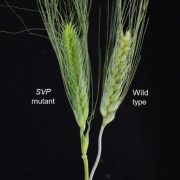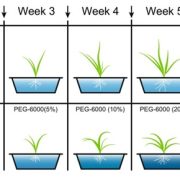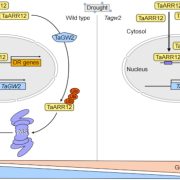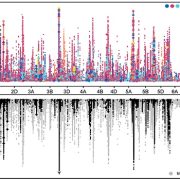TaGSK3 regulates the Green Revolution Protein Rht-B1b to reduce wheat plant height
Huixue Dong1,2,3, Danping Li1,3, Ruizhen Yang1, Lichao Zhang1, Yunwei Zhang1, Xu Liu1, Xiuying Kong1,*, and Jiaqiang Sun1,*
- State Key Laboratory of Crop Gene Resources and Breeding, Institute of Crop Sciences, Chinese Academy of Agricultural Sciences, Beijing, China
- State Key Laboratory of Crop Gene Exploration and Utilization in Southwest China, Sichuan Agricultural University, Chengdu, Sichuan, China
- These authors contributed equally to this work.
*Corresponding authors.
Background: For wheat (Triticum aestivum), plant height is a crucial agronomic trait because high plants are prone to lodging (falling over). During the Green Revolution in the 1960s, the unprecedented wheat yield increases were achieved through the introduction of Reduced height (Rht)-B1b and Rht-D1b semi-dwarfing alleles, which confer increased harvest index and improved lodging resistance. Rht-B1b and Rht-D1b alleles produce N-terminal truncated DELLA proteins generated by translational re-initiation, which are stabilized by lacking an intact DELLA motif, leading to reduced plant height. The DELLA proteins are well known as negative regulators of gibberellin signaling in plants. However, the molecular basis of how the Green Revolution proteins Rht-B1b and Rht-D1b act to reduce plant height in wheat remains to be clarified.
Question: How is the stabilized Rht-B1b protein activated or regulated to reduce plant height in wheat?
Findings: We cloned a gain-of-function allele of GSK3 gene through characterization of a dwarf wheat mutant. The GSK3 kinase was shown to interact with and phosphorylate Rht-B1b to promote it to reduce wheat plant height. The phosphorylation by GSK3 may enhance the activity and stability of Rht-B1b. Moreover, GSK3-mediated plant growth repression requires DELLA proteins. Overall, we uncover an activation mechanism for the Green Revolution protein Rht-B1b, which not only needs to be stabilized but also needs to be activated by direct phosphorylation via GSK3 to exert its function in reducing wheat plant height.

Next steps: We plan to generate more wheat mutants with modified plant architecture by CRISPR/Cas9 or EMS-mutagenesis and elucidate the regulatory network of wheat plant architecture, which will provide new insights and elite genes for wheat improvement.
Reference:
Huixue Dong, Danping Li, Ruizhen Yang, Lichao Zhang, Yunwei Zhang, Xu Liu, Xiuying Kong and Jiaqiang Sun (2023) GSK3 phosphorylates and regulates the Green Revolution protein Rht-B1b to reduce plant height in wheat. Plant Cell. https://doi.org/10.1093/plcell/koad090
题目:TaGSK3帮助绿色革命蛋白Rht-B1b降低小麦株高
背景回顾:株高是小麦重要的性状之一,株高太高容易出现倒伏。在20世纪60年代的“绿色革命”期间,通过引入半矮化等位基因Rht-B1b和Rht- D1b,提高了小麦收获指数和抗倒伏能力,使小麦产量获得了前所未有的提高。Rht-B1b和Rht-D1b等位基因通过重新启动转录产生N端截断的DELLA蛋白。DELLA蛋白由于缺乏完整的DELLA基序而变得稳定,导致株高降低。众所周知,DELLA蛋白是植物赤霉素信号传导的负调控因子。然而,绿色革命蛋白(Rht-B1b和Rht-D1b)如何降低小麦株高的分子基础仍不清楚。
科学问题:稳定的Rht-B1b蛋白是如何被激活或调控以降低小麦株高?
研究发现:通过分析一个小麦矮秆突变体,我们克隆到了功能获得性的TaGSK3等位基因。发现TaGSK3激酶可以与绿色革命蛋白Rht-B1b相互作用并磷酸化Rht-B1b,进而促进Rht-B1b实现降低小麦株高的生物学功能。试验分析表明TaGSK3介导的磷酸化可以增强Rht-B1b的活性和稳定性。此外,TaGSK3介导的生长抑制作用依赖于DELLA蛋白的功能。我们揭示了一个小麦绿色革命蛋白Rht-B1b的激活机制:Rht-B1b蛋白不仅需要稳定,还需要被TaGSK3激酶直接磷酸化激活,才能发挥其降低小麦株高的作用。
展望未来:我们计划通过CRISPR-Cas9或EMS诱变创制更多株型变异的小麦突变体,并阐明小麦株型的调控网络,为小麦株型改良提供新的思路和优异基因资源。









